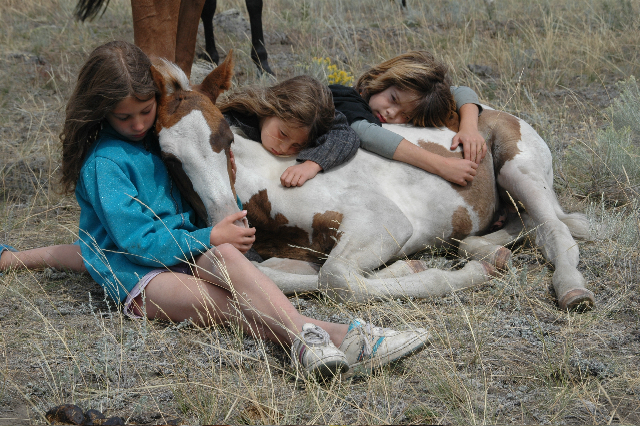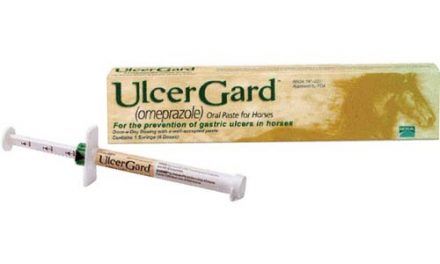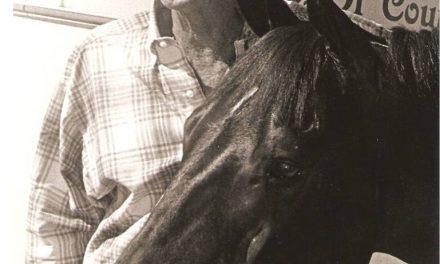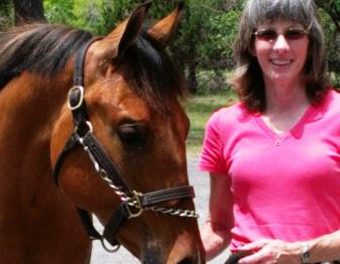De-sensitization and imprinting are tools many trainer’s use Their importance to our efficient handling of horses is invaluable. From a human perspective our interaction with horses from handling to riding is safer and less stressful. Its value to a trusting partnership though is dependent on how sensitive and considerate we are to the horse. Is our horse enjoying the relationship more as a result or are they simply dead to the stimulus?
As a warmblood breeder I have birthed and raised dozens of foals. I have been a breeder now for fourteen years and have developed through the process a more holistic and rewarding approach of imprinting similar to how we welcome humans to the world. There are several important ideas involved:
A GOOD RELATIONSHIP WITH THE FOAL STARTS WITH THE DAM
In order for my mare to welcome me at the birth she must first consider me a friend to be trusted with her well-being. This is a life long process but a simple lead in is to genuinely consider her; to be kind and generous as we would be to a human friend. One of the best ways to a mares’ heart is through her stomach and making a fuss over her condition by preparing wholesome healthy meals and snacks will have her nickering the minute she sees you. Grooming, scratching and forays to find choice patches of succulent grass are also great bonding exercises.
All of this will be time well spent as she will transfer her feelings about you to the new foal. Animals learn by example and the foal will watch his mother closely to see how she responds to her human caregiver.
HELP MAKE YOUR MARES BIRTHING EXPERIENCE WONDERFUL
In keeping with the relationship you have fostered with your mare, be there when she is birthing and help make it easier for her. Because my mare knows her well-being is everything to me she welcomes me at the birth. When the water breaks and the sack appears, I immediately check the position of the foal. In a normal birth one foot is presented slightly ahead of the other, soles down. If it is any other way make an emergency call to your vet!
Holding the foals front pasterns and pulling with the mares contractions will help her labor proceed more easily, and when the nose appears, break the sack so the baby can breathe. If all goes smoothly birth usually occurs about twenty to thirty minutes after the water breaks.
BE SENTISIVE AND GENTLE
Imprinting can be loving and helpful rather than disruptive and invasive. Harsh imprinting methods advise taking the baby away from it’s mother at birth and performing a series of extreme de-sensitizing exercises which are designed to deaden the foals reaction to simple procedures like trimming and shoeing by tapping the soles of it’s feet repeatedly, veterinary treatment by sticking fingers in all of it’s orifices, electric clippers, plastic bags; the list goes on and on. All of this forms the babies first impression of the world while its’ mother is restrained and not allowed to welcome her own baby.
I have a loft above my birthing stall and when the mare waxes I sleep there so I can hear her pacing and when the water breaks and the embryonic sack appears. I am then right there to assist and make the process as easy as possible. The mare usually gets down and prepares to push when the sack appears, so I tear the sack open , check that the foal is in alignment (one foot slightly in front of the other and hooves facing down) and then I help gently pull the baby down towards the mares hooves and out with each contraction. When the head and front of the foal appears, I help stimulate the breathing by rubbing gently with a towel and checking that the nasal passages are clear.
In my barn the foal is towel dried and loved between my kissing and congratulating the mare until it breaks the umbilical cord. I then help it to get close to the still recovering mom so she can lick all the places I have just dried and the two of us alternate in one big welcome fest. The mare then rises and I clip her placenta back up to itself so she won’t step on the trailing end and tear it. It is the weight of the placenta that helps it separate cleanly from the uterine wall without leaving bits that can cause serious infection.
All the while the baby is attempting to stand and when he succeeds will then begin his search for the mare’s udder. It is better to give him time (up to two hours) to find it on his own and most mares will try to help by getting in position and pushing the foal in the right direction.
When I can, I help the baby balance or get closer to the right spot. When he lies down to rest I will sit next to him, talking gently and stroking all over his body lovingly. I touch his ears and muzzle and feet but not invasively and I talk to my mare and praise her for a job well done. We are a family together in this loving experience.
This is all a welcome not a de-sensitization process. My primary goal is for the foal to trust me with his welfare and establish a familiar friendship. Take the time it takes to gently and considerately get to know the foal and convince him that your concern is for his comfort and safety. Talk gently, praise him and don’t be in a hurry to restrain him. Your reward will be a great future relationship with your horse.





